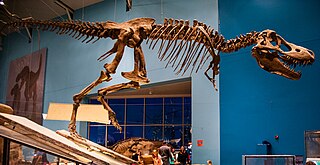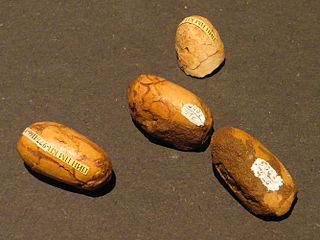
Tarbosaurus is a genus of tyrannosaurine theropod dinosaur that lived in Asia about 70 million years ago, during the Maastrichtian age at the end of the Late Cretaceous period, considered to contain a single known species: Tarbosaurus bataar. Fossils have been recovered from the Nemegt Formation of Mongolia, with more fragmentary remains found further afield in the Subashi Formation of China.

Therizinosaurus is a genus of very large therizinosaurid that lived in Asia during the Late Cretaceous period in what is now the Nemegt Formation around 70 million years ago. It contains a single species, Therizinosaurus cheloniformis. The first remains of Therizinosaurus were found in 1948 by a Mongolian field expedition at the Gobi Desert and later described by Evgeny Maleev in 1954. The genus is only known from a few bones, including gigantic manual unguals, from which it gets its name, and additional findings comprising fore and hindlimb elements that were discovered from the 1960s through the 1980s.

Deinocheirus is a genus of large ornithomimosaur that lived during the Late Cretaceous around 70 million years ago. In 1965, a pair of large arms, shoulder girdles, and a few other bones of a new dinosaur were first discovered in the Nemegt Formation of Mongolia. In 1970, this specimen became the holotype of the only species within the genus, Deinocheirus mirificus; the genus name is Greek for "horrible hand". No further remains were discovered for almost fifty years, and its nature remained a mystery. Two more complete specimens were described in 2014, which shed light on many aspects of the animal. Parts of these new specimens had been looted from Mongolia some years before, but were repatriated in 2014.

Avisaurus is a genus of enantiornithine bird from the Late Cretaceous of North America.

Hulsanpes is a genus of halszkaraptorine theropod dinosaurs that lived during the Late Cretaceous in what is now the Barun Goyot Formation of Mongolia, about 75-72 million years ago. The remains were found in 1970 and formally described in 1982 by Halszka Osmólska, who noted that the genus is represented by an immature individual. Hulsanpes represents the first record of the basal dromaeosaurid subfamily Halszkaraptorinae.

Gobipteryx is a genus of prehistoric bird from the Campanian Age of the Late Cretaceous Period. It is not known to have any direct descendants. Like the rest of the enantiornithes clade, Gobipteryx is thought to have gone extinct near the end of the Cretaceous.

The Nemegt Formation is a geological formation in the Gobi Desert of Mongolia, dating to the Late Cretaceous. The formation consists of river channel sediments and contains fossils of fish, turtles, crocodilians, and a diverse fauna of dinosaurs, including birds.
Nanantius is a genus of extinct enantiornithean avialan known from the Early Cretaceous of Australia.
Zhyraornis is a genus of prehistoric bird from the late Cretaceous period. Its fossils have been found in Bissekty Formation deposits near Dzharakuduk in the Kyzyl Kum, Uzbekistan. Two species have been assigned to this genus: Zhyraornis kashkarovi and Zhyraornis logunovi. Both are known only from partial pelvic bones (synsacra).
Lenesornis is a genus of enantiornithine birds which lived during the Late Cretaceous about 90 Ma and is known from fossils found in the Bissekty Formation in the Kyzyl Kum, Uzbekistan.
Teviornis is a genus of extinct birds. One species has been described, T. gobiensis. It lived in the Maastrichtian stage at the end of the Late Cretaceous period, some 70 million years ago. It is known from fossils collected from the Nemegt Formation of Gobi, south Mongolia.
Apsaravis is a Mesozoic bird genus from the Late Cretaceous. The single known species, Apsaravis ukhaana, lived about 78 million years ago, in the Campanian age of the Cretaceous period. Its fossilized remains were found in the Camel's Humps sublocality of the Djadokhta Formation, at Ukhaa Tolgod in the Gobi Desert of Mongolia. They were collected in the 1998 field season by the Mongolian Academy of Sciences/American Museum of Natural History Paleontological Expeditions. It was described by Norell and Clarke (2001).

Ceratonykus is a monospecific genus of alvarezsaurid dinosaur from Mongolia that lived during the Late Cretaceous in what is now the Barun Goyot Formation. The type and only species, Ceratonykus oculatus, is known from a fragmentary skeleton, including an incomplete skull, of an adult individual. It was named and described in 2009 by Vladimir Alifanov and Rinchen Barsbold. Its describers questioned the traditional placement of alvarezsaurs in Theropoda, instead suggesting they were ornithischians, but this has not been accepted since. Ceratonykus has an estimated length of 75 centimetres and weight of 760 grams. It has been considered as a possible junior synonym of Parvicursor.

Paralligator is an extinct genus of neosuchian crocodylomorph that lived during the Late Cretaceous (Cenomanian-Maastrichtian) period in what is now the Bayan Shireh and Nemegt formations of Mongolia, approximately 96 million to 70 million years ago. P. gradilifrons reached up to 4 m (13 ft) in length.

Macroolithus is an oogenus of dinosaur egg belonging to the oofamily Elongatoolithidae. The type oospecies, M. rugustus, was originally described under the now-defunct oogenus name Oolithes. Three other oospecies are known: M. yaotunensis, M. mutabilis, and M. lashuyuanensis. They are relatively large, elongated eggs with a two-layered eggshell. Their nests consist of large, concentric rings of paired eggs. There is evidence of blue-green pigmentation in its shell, which may have helped camouflage the nests.
Subtiliolithus is an oogenus of fossil egg from the Nemegt Formation of Mongolia and the Ohyamashimo Formation of Japan. The eggs are notable for a very thin eggshell. It contains three oospecies: S. hyogoensis, S. kachchhensis and S. microtuberculatus. They were originally classified as a distinct oofamily, Subtiliolithidae, but numerous similarities to Laevisoolithus have led to their reclassification as Laevisoolithid eggs. A complete skeleton of Nanantius valifanovi was found associated with Subtiliolithus eggshells, indicating that the oogenus represents eggs of enantiornithine birds.
Martinavis is a genus of enantiornithine birds which existed in what is now southern France, North America and Salta Province, Argentina during the late Cretaceous period. It was named by Cyril A. Walker, Eric Buffetaut and Gareth J. Dyke in 2007, and the type species is Martinavis cruzyensis.

Gobioolithus is an oogenus of fossil bird egg native to Mongolia. They are small, smooth-shelled, and elongated eggs that were first discovered in the 1960s and early 70s during a series of fossil-hunting expeditions in the Gobi desert. Two oospecies have been described: Gobioolithus minor and G. major. The eggs were probably laid in colonial nesting sites on the banks of rivers and lakes.

Yatenavis is an extinct genus of enantiornithine bird from the Late Cretaceous Chorrillo Formation of Santa Cruz Province, Argentina. The genus contains a single species, Y. ieujensis, known from a partial humerus.













